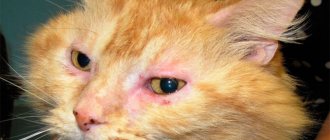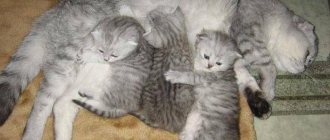Normal and abnormal course of labor
Prevention of all possible complications during childbirth begins with caring for a pregnant cat . As soon as you discover that your pet is pregnant, regardless of whether mating was planned, she must be shown to a veterinarian.
A cat's pregnancy can be determined from 2–3 weeks using a blood test. At 3–4 weeks, the expectant mother's mammary glands swell. As the gestation period increases, the following signs are observed:
- Increased hunger.
- Redness of the nipples.
- Toxicosis.
- Slight but constant weight gain.
- Behavioral changes - frequent meowing, restlessness, unusual affection or irritability.
During the normal course of pregnancy, by about 5–6 weeks, the pet’s belly becomes noticeably rounded. If gestation proceeds without complications, the cat receives decent care, has no genetic defects, and birth occurs from 64 to 71 days of pregnancy.
Important! During the normal course of pregnancy, before the onset of contractions, the cat should not experience any discharge from the genitals. The only exception is early rejection of the mucus plug, which can occur several weeks before birth.
It will be easier for an inexperienced owner to cope with the situation if the nest for birth is prepared in advance. It is necessary to monitor the cat’s behavior; most often, she herself chooses a suitable (from her point of view) place. You can take the initiative and equip a nest for your cat from a spacious box. In order for the expectant mother to feel safe, the box must be closed (have a roof).
During the first contractions, you may find that the cat is restless, constantly entering the nest, or looking for a suitable place to give birth to kittens. The pet can meow loudly and attract the attention of the owner, especially if she is about to give birth for the first time. The first contractions bring discomfort, but the cat successfully hides the pain. The owner may not notice the discharge of amniotic fluid and the rejection of the mucous plug, since the cat licks the genital area.
As the labor process progresses, contractions will intensify and the interval between them will decrease. When the interval is reduced to 20–30 seconds, the cat will lie down on its side and prepare to push.
The first kitten takes longer to be born than all the others; to expel it, the cat will need to make 3-4 strong attempts. The total duration of the process from the start of contractions to the appearance of the first kitten can take from 2 to 24 hours. Normally, contractions last up to 12 hours, and pushing at the birth of the first kitten lasts up to 1 hour.
Note! After the birth of the first kitten, the remaining babies should appear at intervals of 10–20 minutes.
As soon as the baby is born, the cat licks its face, gnaws the umbilical cord and eats the afterbirth. If the woman in labor does not pay attention to the kitten, and the expulsion occurs too quickly, the pet may be in rapid labor. This complication is associated with severe pain, so it is advisable to immediately remove the kittens from the nest, remove fluid from the respiratory tract, rub them and place them on a heating pad.
What signs can you use to know that a cat is about to give birth?
Pregnancy in cats lasts 7-8 weeks (58-67 days). The birth itself can last from 2-3 hours to a day, depending on the number of kittens, the age of the mother and her health.
To understand how to give birth to a cat at home, you should memorize the signs that indicate that labor is about to begin.
Cat before giving birth
Harbingers of childbirth:
- 2-3 days before giving birth, the animal’s temperature drops sharply to 37.0-37.5 °C (the normal temperature of cats is 38.5 - 39.0 °C). But, unlike dogs, this does not always happen.
- The activity of the pregnant woman noticeably decreases, but the activity of the kittens in the stomach increases. You can feel how worried they are through your stomach.
- 1-2 days before giving birth, the cat suddenly becomes restless, looks for a secluded place, digs, licks the genitals and stomach, and throws things out of closets.
- Also, within 1-2 days the expectant mother produces milk. It can be noticed if you apply light pressure at the base of the nipple.
- On the day of birth, the pet refuses to eat or eats very little.
- Just before giving birth, your cat's mucus plug comes off. It is quite difficult to notice this, because usually the animal licks it off.
- Next, the amniotic fluid leaves. They are yellowish in color and have a specific smell.
- With the onset of contractions, the cat continues to try to hide, dig a “hole”, screams more intensely, but from time to time lies down, breathes heavily and licks the genitals.
Pets most often give birth at night or early in the morning, so you should be prepared for this.
Help with prolonged labor
Make it a rule not to interfere with the birth process until you are sure that the woman in labor needs help. Stimulation of the birth process and other interventions can harm not only the kittens, but also the pet.
Be sure to contact your veterinarian if you notice the following complications:
- Black, green, bloody, or foul-smelling discharge during labor.
- Labor lasts longer than 36 hours.
- Contractions last more than 12 hours.
- Pushing that lasts longer than 30–60 minutes and does not produce a kitten.
- An amniotic sac has appeared in the birth canal, but the horse cannot push it out for more than 10 minutes.
With such complications, self-help is not only useless, but also dangerous. If you cannot call a veterinarian at home, ask for instructions over the phone. Listen carefully to how to induce labor in a cat, write down the names of the medications and pay special attention to the dosage.
To stimulate labor or pushing, the well-known drug Oxytocin . The average dosage is 0.3 ml once an hour, for a cat weighing 4–5 kg. Oxytocin is not recommended to be administered more than three or four times, since excessive stimulation can lead to weakening of the body, damage to the birth canal and bleeding.
Note! Oxytocin is used for several purposes: to speed up labor, resume contractions or pushing, enhance or initiate lactation.
If difficulties in childbirth occur due to the fact that a dead kitten is stuck in the tract, after its expulsion it is necessary to carry out resuscitation measures. Open the amniotic sac and remove amniotic fluid from the respiratory tract using a syringe without a needle. Actively rub the kitten with a dry towel; if it does not begin to breathe or move, place it on a heating pad and continue rubbing the body from the limbs to the sternum.
Note! If the kitten's skin turns pink when rubbed and warmed, it means there is blood flow and you still have a chance to revive the baby.
When you contact your veterinarian, you will most likely be given several options:
- Use of Oxytocin.
- C-section.
When is it appropriate to induce labor and when to perform a cesarean section?
When do you really need to speed up labor? As a rule, in cases where the animal has atony (complete absence) or hypotension (weak contractions) of the uterus. But it should be remembered that the rigidity of the uterine wall should be normal. In other words, in cases where the animal is already exhausted and weakened by long, protracted labor, it is not recommended to resort to stimulating uterine contractions. As in the situation already described above, such “help” can lead to rupture of the walls of the organ.
In addition, in no case should they “force” the birth process if there is even the slightest suspicion of malpresentation or congenital deformities of the fetus. Intensified contractions of the uterine wall in these cases can lead to severe injuries, rupture of the walls of the organ and, subsequently, the death of the animal from internal bleeding.
In case of prolonged labor, kittens blocking the birth canal due to malpresentation, deformities and large fetuses, it is strongly recommended to immediately use a cesarean section.
What to do in cases where the death of cubs is suspected? Most likely, a caesarean section is also preferable. This is due to the need to clean the entire uterine cavity, remove putrefactive secretions and other decay products from there, and, possibly, further remove the organ itself (as well as the ovaries).
Third stage of labor
The third stage of labor is the state of calm of the cat's uterus in the interval between the birth of babies. It lasts about fifteen minutes. During this period, the cat can drink some water. Often the cat also eats the afterbirth, which comes out after the kitten is born. But you should not allow your pet to eat more than two afterbirths. This can cause stomach upset for the new mother.
INTERESTING: The number of placenta during childbirth in cats should be the same as the number of kittens born. If the placenta does not come out, the owner needs to help his pet remove it. If this is not done, the cat may develop serious inflammation.
It is impossible to accurately determine the duration of labor in cats, because this is a very individual process. There are individuals who cope within a couple of hours, and for some, prolonged labor lasts up to 36 hours.
How long does a cat's pregnancy last and when is it due?
On average, pregnancy lasts about three months, from 60 to 63 days.
But there are some nuances:
- yard cats generally give birth on the 50th day of gestation;
- Siamese cat breed, usually gives birth between 70 and 75 days ;
- cats with a small body composition, such as British and Scottish breeds, give birth in 60 - 65 days , and those who are obese often overweight;
- in young individuals before the first year of life, premature births often occur and the offspring often die.
The maximum permissible duration is 71 days. Minimum from 56 to 60 days.
Helping a newborn kitten
There are cases when a cat, having just given birth to her cubs, does nothing towards them. Then the owner of the new mother must get down to business.
The kitten needs to be helped to free itself from the amniotic sac and gently blow into its nose. Then squeeze the umbilical cord at a distance of a couple of centimeters from the baby, tie it with surgical thread and trim it with sterile scissors. The wound should be smeared with green paint, and the baby should be pushed towards the mother’s nipples.
When the kitten begins to eat milk, the cat's maternal instinct will take over and she will continue to take care of the offspring without the help of the owner.
To prepare for the birth of your mustachioed pet, you can read a lot of information, watch videos on the Internet and follow all kinds of advice. And if everything goes smoothly, the cat can easily give birth. But, no matter what knowledge and skills the owner of a pregnant cat has, if during childbirth there are doubts about the correctness of what is happening, it is imperative to take action and call a veterinary obstetrician. It’s better to play it safe so that everything goes well for the new mother and her cubs.
How to induce labor in a cat, what to do if the expectant mother is overdue? Is it possible to stimulate contractions and what are the consequences? Let's understand the intricacies of the birth process and possible complications.
Second stage of labor
At this stage, the abdominal muscles and diaphragm begin to move - strong attempts begin. The first kitten is moving towards a new life. The amniotic sac ruptures and some amniotic fluid leaks out of the cat's vagina. The cat at this moment lies on its side, in some cases stands or sits. Kittens, like humans, are born head first, although breech presentation is the norm.
After the kitten is born, the cat licks it, frees it from the amniotic sac, gnaws the umbilical cord and puts it to the chest.











